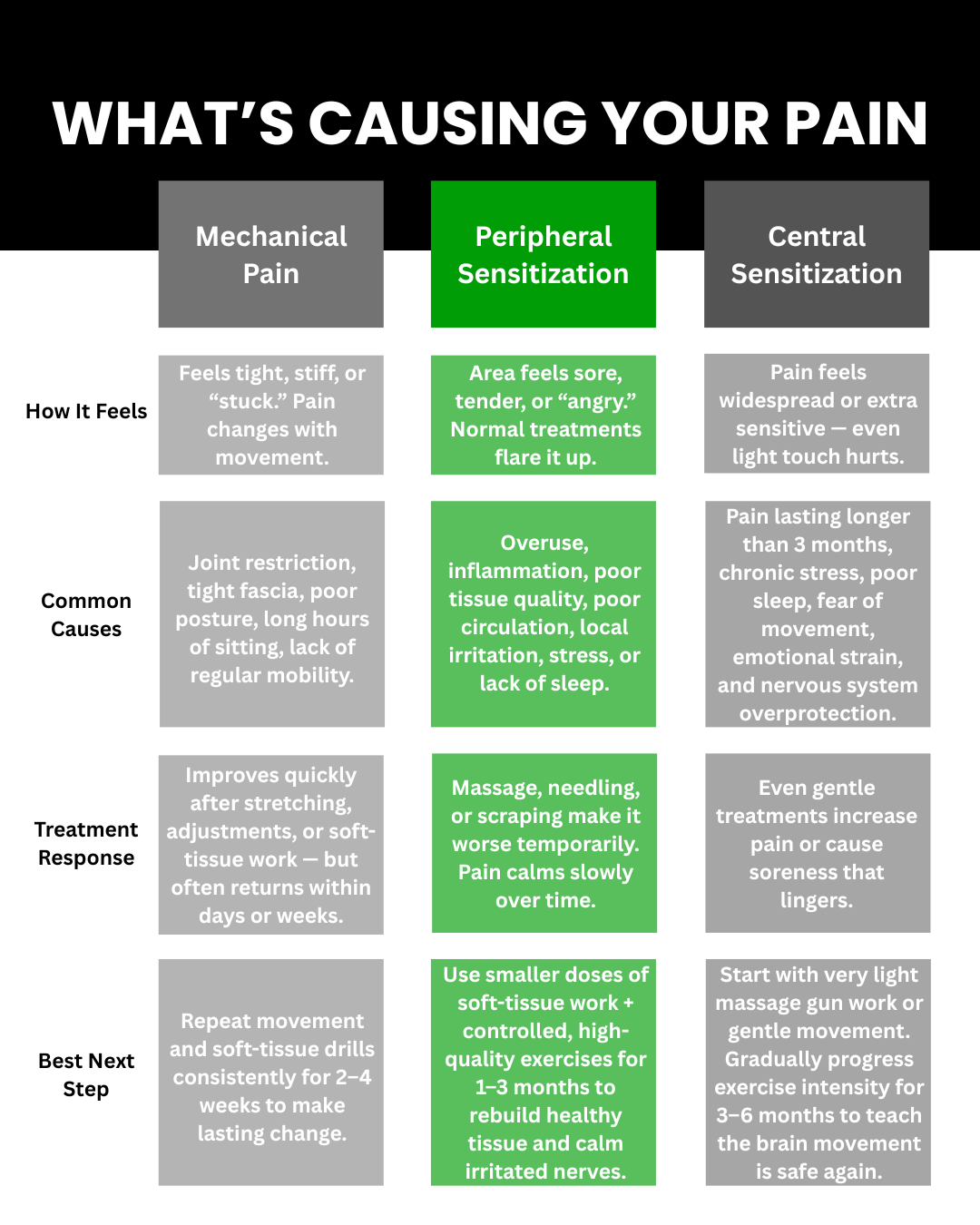- Move More Minute
- Posts
- Wwhy your pain won’t go away
Wwhy your pain won’t go away
Most people never learn which of the 3 pain types they have — and it’s why recovery never lasts.

Read Time: 4 minutes
Hey there!
If your pain keeps coming back or gets worse any time you try something no matter what treatment you do (PT, chiropractic, massage, injections), chances are the real problem hasn’t been identified yet.
Most practitioners focus on where it hurts, not why it keeps hurting.
In my clinic, I’ve found that almost every case of chronic pain fits into one of three categories: mechanical pain, peripheral sensitization, and central sensitization
Once you know which one you’re dealing with, recovery becomes much more predictable — and progress usually feels a lot easier.

⚠️ Why This Matters
Central sensitization is one of the biggest reasons I encourage people to address pain early — before it becomes long-term.
Pain that lasts for more than three months can start to “train” the brain to stay on high alert, even after tissues heal. Recovery is still possible, but it takes time and consistency.
When pain keeps returning, it’s not about pushing through. It’s about understanding why and working with your body instead of against it.
💬 Why I Test Before Prescribing More Exercises
During your 7-Day Low Back Relief Plan, we start simple: soft-tissue work and a few key movements. Then see how your body responds.
If you get sore easily, it points to sensitization-based pain.
If you feel immediate relief, it’s likely mechanical.
Each type needs a different plan, and guessing rarely works.
That’s why this short test week gives me the information I need to personalize your program and treat the cause, not just the symptoms.
👉 Download the 7-Day Low Back Relief Plan here to see how your body responds and start identifying which pain type you might have.
💬 If It’s Not Just Your Back
If you’ve been dealing with pain somewhere else, like your neck, shoulders, hips, or knees, the same principles apply.
These patterns show up all over the body, and I help people with each of them every day.
If that sounds like you, feel free to reply to this email and tell me what’s been bothering you.
I’ll point you in the right direction or help you set up a time to chat.
🧠 Understanding Your Pain
Once you identify your pain type, things start to make sense, why certain treatments helped for a bit, why others made things worse, and what to actually do next.
That clarity alone can change the way you move, think, and recover.
If you’ve been stuck in the same pain cycle, just know: it’s not about trying harder, it’s about finally understanding what your body has been trying to tell you.
See you next week,

Dr. Matt Moreno, D.C., C.C.S.P.®
The Move More Minute
When you’re ready, here’s how I can help:
The 7-Day Movement Reset – If pain is keeping you from moving the way you want, this free reset helps you understand what’s holding you back and gives you a clear plan to start feeling better.
Free Resources – Check out our guides and protocols under the Resources tab on our website.
What did you think of today's newsletter? |
Disclaimer: The information provided in this newsletter is for educational and informational purposes only and is not intended as a substitute for professional medical advice, diagnosis, or treatment. Always seek the advice of your physician, chiropractor, or other qualified healthcare provider with any questions you may have regarding a medical condition or before starting any new exercise program.
The exercises and suggestions provided are general recommendations and may not be suitable for everyone. If you experience pain, discomfort, or any concerning symptoms while performing these exercises (such as numbness, dizziness, or increased pain), stop immediately and consult a qualified healthcare professional.
Do not disregard professional medical advice or delay seeking it because of something you have read in this newsletter. The author, Move More Minute, and its affiliates assume no responsibility for injuries or issues that may arise from following the recommendations provided. By engaging with this content, you agree to do so at your own risk.
For personalized care or specific advice, please schedule an appointment with a qualified professional.